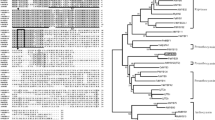Abstract
An important traditional Chinese medicine herb, Astragalus membranaceus var. Mongholicus, whose dried root is known as Radix astragali (“Huangqi” in Chinese), has high flavonoid content as an essential active constituent. Phenylalanine ammonia-lyase (PAL, EC 4.3.1.5) catalyzes the first and also a rate-limiting step in phenylpropanoid pathway, which supplies precursors for a variety of secondary metabolites including flavonoids. A PAL gene, designated AmPAL1 (GenBank accession no. AY986506), was isolated from A. membranaceus var. Mongholicus with a full-length cDNA of 2562 nucleotides and an open reading frame of 2154 bp. Northern blot analysis revealed that AmPAL1 expressed universally in different organs, and its expression was markedly induced by UV irradiation, mechanical wounding, and white light irradiation on etiolated seedlings, with some distinctive responsive properties. Content of a typical flavonoid, quercetin, in A. membranaceus var. Mongholicus of different ages correlated with PAL enzymatic activity. Transgenic tobacco plants harboring AmPAL1 under the control of the CaMV35S promoter showed significantly increased PAL activity and correlatively increased quercetin content than those in non-transformed plants. These results indicate that PAL is maybe a key point for flux into flavonoid biosynthesis in the genetic control of secondary metabolism in A. membranaceus var. Mongholicus.




Similar content being viewed by others
References
Bate NJ, Orr J, Ni W, Meromi A, Nadler-Hassar T, Doerner PW, Dixon RA, Lamb CJ, Elkind Y (1994) Quantitative relationship between phenylalanine ammonia-lyase levels and phenylpropanoid accumulation in transgenic tobacco identifies a rate-determining step in natural product synthesis. Proc Natl Acad Sci USA 91:7608–7612
Campos-Vargas R, Saltveit ME (2002) Involvement of putative chemical wound signals in the induction of phenolic metabolism in wounded lettuce. Physiol Plantarum 114:73–84
Campos R, Nonogaki H, Suslow T, Saltveit ME (2004) Isolation and characterization of a wound inducible phenylalanine ammonia-lyase gene (LsPAL1) from Romaine lettuce leaves. Physiol Plantarum 121:429–438
Cantos E, Espín JC, Tomás-Barberán FA (2001) Effect of wounding on phenolic enzymes in six minimally processed lettuce cultivars upon storage. J Agric Food Chem 49:322–330
Dixon RA, Paiva NL (1995) Stress-induced phenylpropanoid metabolism. Plant Cell 7:1085–1097
Gläβgen WE, Rose A, Madlung J, Koch W, Gleitz J, Seitz HU (1998) Regulation of enzymes involved in anthocyanin biosynthesis in carrot cell cultures in response to treatment with ultraviolet light and fungal elicitors. Planta 204:490–498
Howles PA, Sewalt VJH, Paiva NL, Elkind Y, Bate NJ, Lamb C, Dixon RA (1996) Overexpression of l-phenylalanine ammonia-lyase in transgenic tobacco plants reveals control points for flux into phenylpropanoid biosynthesis. Plant Physiol 112:1617–1624
Jaakola L, Määttä-Riihinen K, Kärenlampi S, Hohtola A (2004) Activation of flavonoid biosynthesis by solar radiation in bilberry (Vaccinium myrtillus L.) leaves. Planta 218:721–728
Kamo T, Hirai N, Tsuda M, Fujioka D, Ohigashi H (2000) Changes in the content and biosynthesis of phytoalexins in banana fruit. Biosci Biotechnol Biochem 64:2089–2098
Kostenyuka IA, Zońb J, Burnsa JK (2002) Phenylalanine ammonia lyase gene expression during abscission in citrus. Physiol Plantarum 116:106–112
Krasteva I, Nikolova I, Danchev N, Nikolov S (2004) Phytochemical analysis of ethyl acetate extract from Astragalus corniculatus Bieb. and brain antihypoxic activity. Acta Pharm 54:151–156
Liang X, Dron M, Cramer CL, Dixon RA, Lamb CJ (1989) Differential regulation of phenylalanine ammonia-lyase genes during plant development and by environmental cues. J Biol Chem 264:14480–14492
Logemann E, Parniske M, Hahlbrock K (1995) Modes of expression and common structural features of the complete phenylalanine ammonia-lyase gene family in parsley. Proc Natl Acad Sci USA 92:5905–5909
Logemann E, Tavernaro A, Schulz W, Somssich IE, Hahlbrock K (1999) UV light selectively coinduces supply pathways from primary metabolism and flavonoid secondary product formation in parsley. Proc Natl Acad Sci USA 97:1903–1907
Ma XQ, Shi Q, Duan JA, Dong TTX, Tsim KWK (2002) Chemical analysis of Radix Astragali (Huangqi) in China: a comparison with tts adulterants and seasonal variations. J Agric Food Chem 50:4861–4866
McCallum JA, Walker JRL (1990) Phenolic biosynthesis during grain development in wheat changes in phenylalanine ammonia lyase activity and soluble phenolic content. J Cereal Sci 11:35–49
Miller AL (1998) Botanical influences on cardiovascular disease. Altern Med Rev 3:422–431
Rasmussen S, Dixon RA (1999) Transgene-mediated and elicitor-induced perturbation of metabolic channeling at the entry point into the phenylpropanoid pathway. Plant Cell 11:1537–1551
Sanchez-Ballesta MT, Lafuente MT, Zacarias L, Granell A (2000) Involvement of phenylalanine ammonia-lyase in the response of Fortune mandarin fruits to cold temperature. Physiol Plantarum 108:382–389
Schuster B, Rétey J (1995) The mechanism of action of phenylalanine ammonia-lyase: the role of prosthetic dehydroalanine. Proc Natl Acad Sci USA 92:8433–8437
Sewalt VJH, Ni W, Blount JW, Jung HC, Masoud SA, Howle PA, Lamb C, Dixon RA (1997) Reduced lignin content and altered lignin composition in transgenic tobacco down-regulated in expression of l-phenylalanine ammonia-lyase or cinnamate 4-hydroxylase. Plant Physiol 115:41–50
Shirley BW (1996) Flavonoid biosynthesis: “new” functions for an “old” pathway. Trends Plant Sci 1:377–382
Sinclair S (1998) Chinese herbs: a clinical review of astragalus, ligusticum, and schizandrae. Altern Med Rev 3:338–344
Tolonen A, Uusitalo J (2004) Fast screening method for the analysis of total flavonoid content in plants and foodstuffs by high-performance liquid chromatography/electrospray ionization time-of-flight mass spectrometry with polarity switching. Rapid Commun Mass Spectrom 18:3113–3122
Xiao HB, Krucker M, Albert K, Liang XM (2004) Determination and identification of isoflavonoids in Radix astragali by matrix solid-phase dispersion extraction and high-performance liquid chromatography with photodiode array and mass spectrometric detection. J Chromatogr A 1032:117–124
Zidorn C, Stuppner H (2001) Chemosystematics of taxa from the Leontodon section Oporinia. Biochem Syst Ecol 29:827–837
Author information
Authors and Affiliations
Corresponding author
Additional information
Communicated by C. F. Quiros
Rights and permissions
About this article
Cite this article
Liu, R., Xu, S., Li, J. et al. Expression profile of a PAL gene from Astragalus membranaceus var. Mongholicus and its crucial role in flux into flavonoid biosynthesis. Plant Cell Rep 25, 705–710 (2006). https://doi.org/10.1007/s00299-005-0072-7
Received:
Revised:
Accepted:
Published:
Issue Date:
DOI: https://doi.org/10.1007/s00299-005-0072-7




